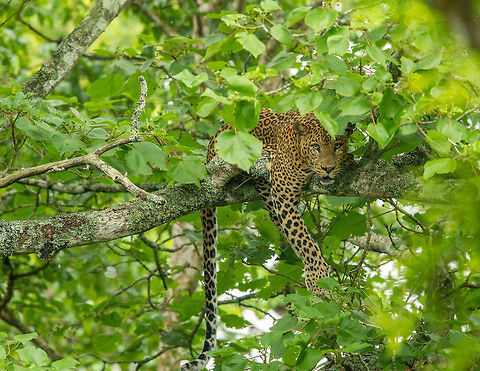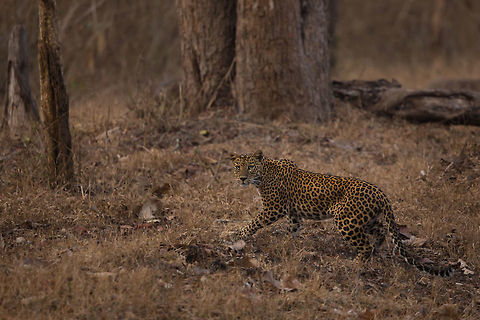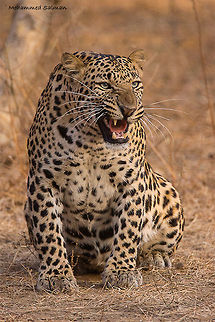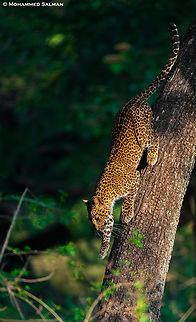
Appearance
In 1794, Friedrich Albrecht Anton Meyer wrote the first description of "Felis fusca", in which he gave account of a panther-like cat from Bengal of about 85.5 cm, with strong legs and a long well-formed tail, head as big as a panther’s, broad muzzle, short ears and small, yellowish grey eyes, light grey ocular bulbs; black at first sight, but on closer examination dark brown with circular darker coloured spots, tinged pale red underneath.Male Indian leopards grow to between 4 ft 2 in and 4 ft 8 in in body size with a 2 ft 6 in to 3 ft long tail and weigh between 110 and 170 lb. Females are smaller growing to between 3 ft 5 in and 3 ft 10 in in body size with a 2 ft 6 in to 2 ft 10.5 in in long tail and weight between 64 and 75 lb.

Distribution
On the Indian subcontinent, topographical barriers to the dispersal of this subspecies are the Indus River in the west, and the Himalayas in the north. In the east, the lower course of the Brahmaputra and the Ganges Delta form natural barriers to the distribution of the Indochinese leopard. Indian leopards are distributed all over India, in Nepal, Bhutan, Bangladesh and parts of Pakistan. In the Himalayas they are sympatric with snow leopards up to 5,200 metres above sea level. They inhabit tropical rain forests, dry deciduous forests, temperate forests and northern coniferous forests but do not occur in the mangrove forests of the Sundarbans.![Black Panther aka melanistic leopard Dream sighting and lucky enough to shoot too! What a weekend in the jungle... this image is 24 hours old! :)
Due to a mutation in the melanin gene, these leopards have Melanism, a development of the dark-colored pigment melanin in the skin or its appendages and is the opposite of albinism. Historically, it was also the medical term for black jaundice [wiki]. Geotagged,India,Indian leopard,Panthera pardus fusca,Spring](https://s3.amazonaws.com/media.jungledragon.com/images/2233/39329_small.jpg?AWSAccessKeyId=05GMT0V3GWVNE7GGM1R2&Expires=1767225610&Signature=mTkR0zgMIQ3EejwEf1h0j8JkoyE%3D)
Status
"Panthera pardus" is listed in CITES Appendix I.Despite India and Nepal being contracting parties to CITES, national legislation of both countries does not incorporate and address the spirit and concerns of CITES. Trained human resources, basic facilities and effective networks for control of poaching and trade in wildlife are lacking.
Frederick Walter Champion was one of the first in India who after World War I advocated for the conservation of leopards, condemned sport hunting and recognised their key role in the ecosystem. Billy Arjan Singh championed their cause since the early 1970s.

Behavior
In Nepal's Bardia National Park, home ranges of male leopards comprised about 48 km2, and of females about 17 km2; female home ranges decreased to 5 to 7 km2 when they had young cubs.In Sariska National Park, the diet of Indian leopards includes axis deer, sambar deer, nilgai, wild pig, common langur, hare and peafowl.

Habitat
On the Indian subcontinent, topographical barriers to the dispersal of this subspecies are the Indus River in the west, and the Himalayas in the north. In the east, the lower course of the Brahmaputra and the Ganges Delta form natural barriers to the distribution of the Indochinese leopard. Indian leopards are distributed all over India, in Nepal, Bhutan, Bangladesh and parts of Pakistan. In the Himalayas they are sympatric with snow leopards up to 5,200 metres above sea level. They inhabit tropical rain forests, dry deciduous forests, temperate forests and northern coniferous forests but do not occur in the mangrove forests of the Sundarbans.In Nepal's Bardia National Park, home ranges of male leopards comprised about 48 km2, and of females about 17 km2; female home ranges decreased to 5 to 7 km2 when they had young cubs.In Sariska National Park, the diet of Indian leopards includes axis deer, sambar deer, nilgai, wild pig, common langur, hare and peafowl.

Predators
Hunting for the illegal wildlife trade has the greatest potential to do maximum harm in minimal time. Apart from poaching, Indian leopards are threatened by loss of habitat and fragmentation of formerly connected populations, various levels of human–leopard conflict in human–dominated landscapes, and competition with other predators.Leopards share their habitats with Asiatic lions, Bengal tigers, Asiatic Black Bears and sloth bears, wolves, Striped hyenas and wild dogs. These animals may kill leopard cubs given a chance. Lions and tigers may even attack a full-grown leopard.Leopards succeed in co-existing with tigers, but are not common in habitat where tiger density is high. They are sandwiched between prime tiger habitat, on the one side, and cultivated village land on the other.
References:
Some text fragments are auto parsed from Wikipedia.